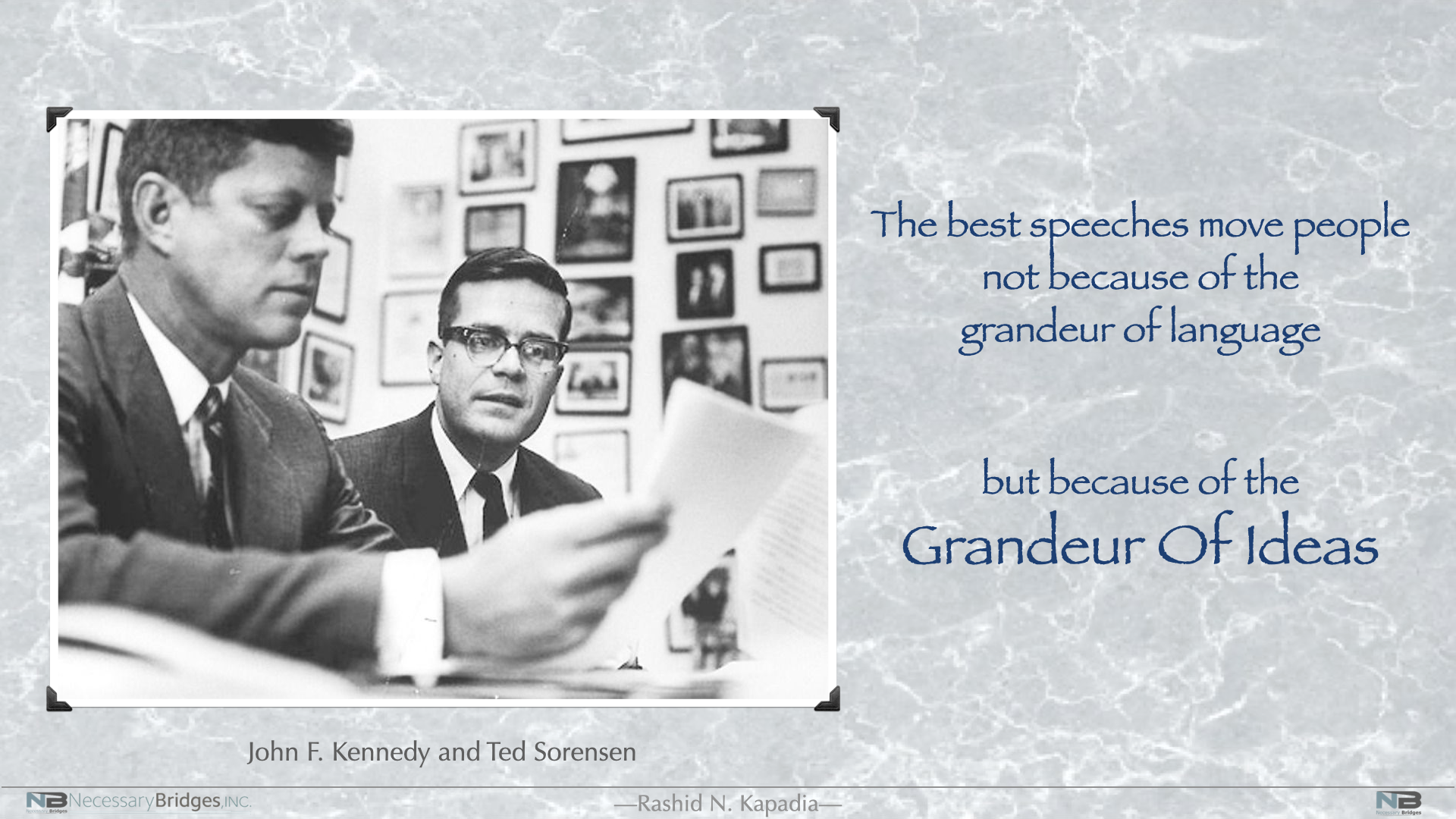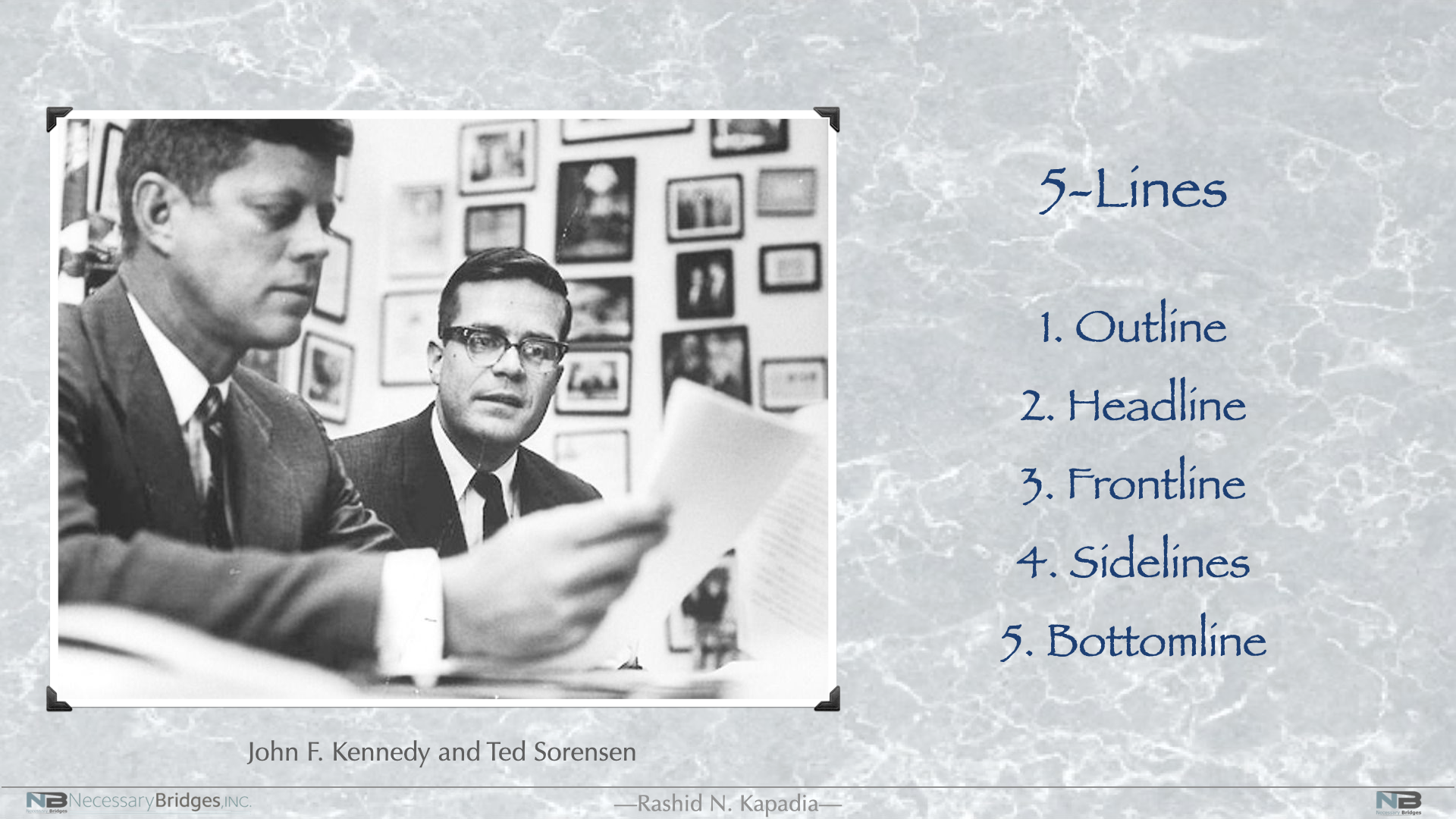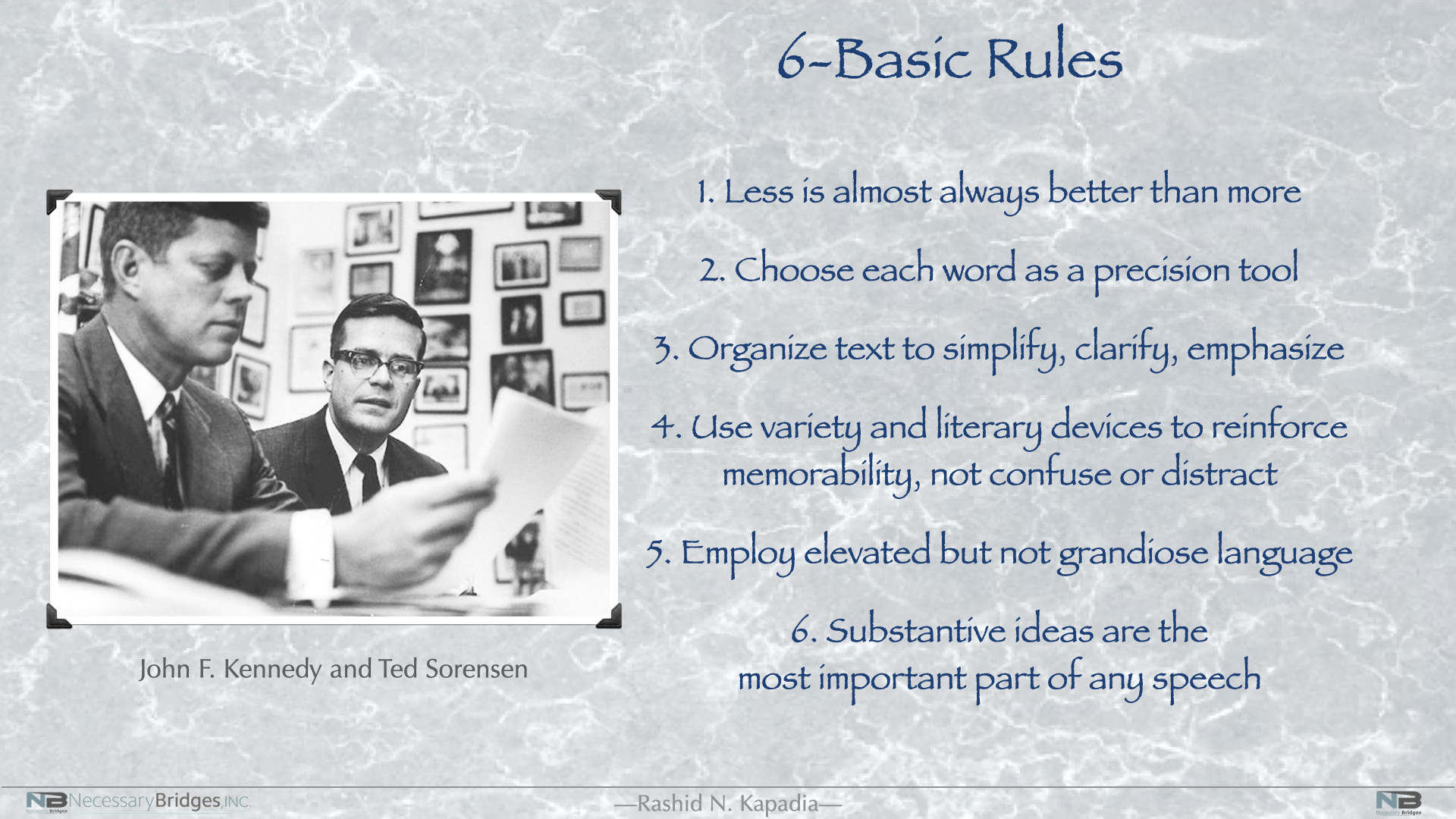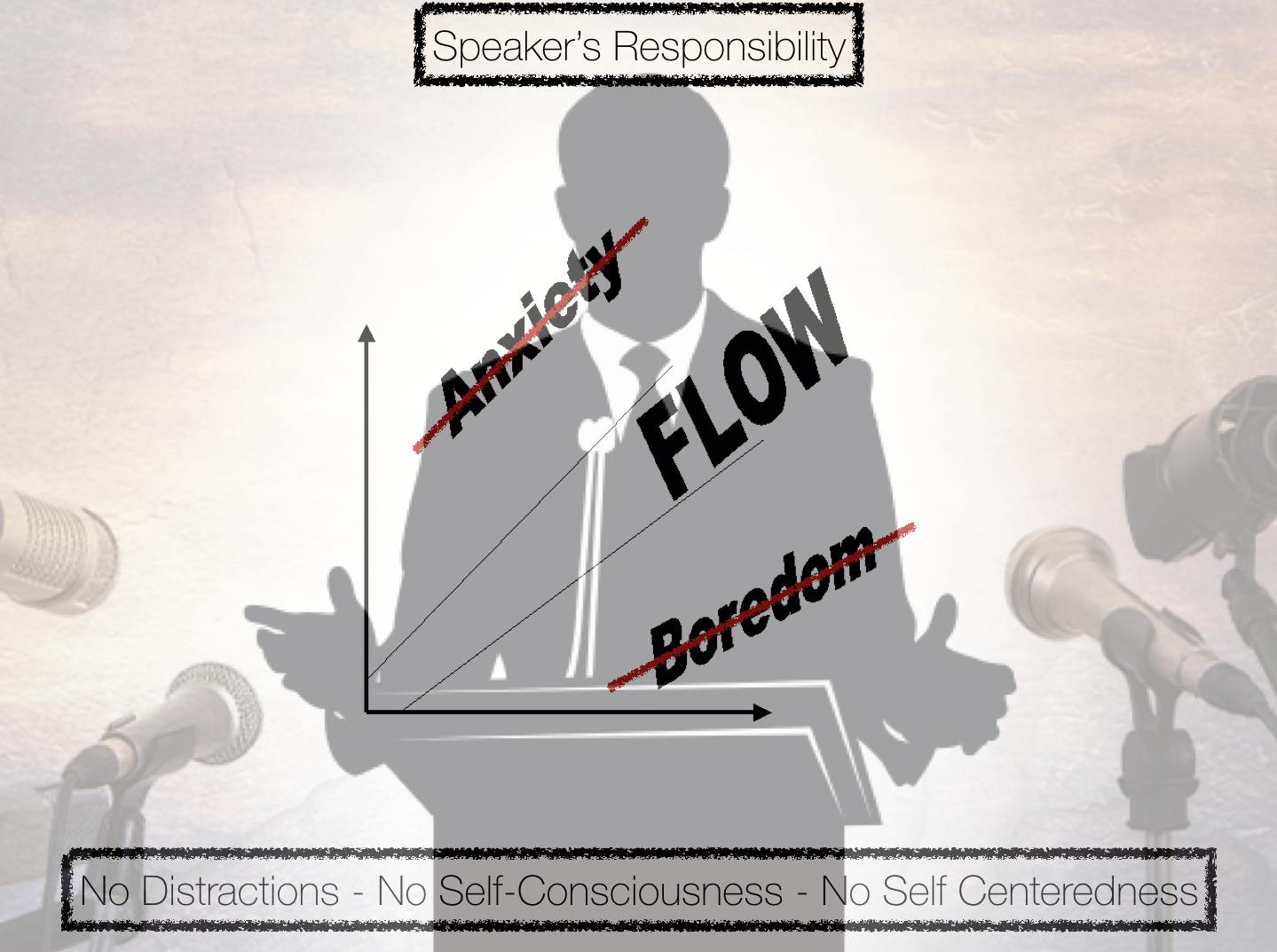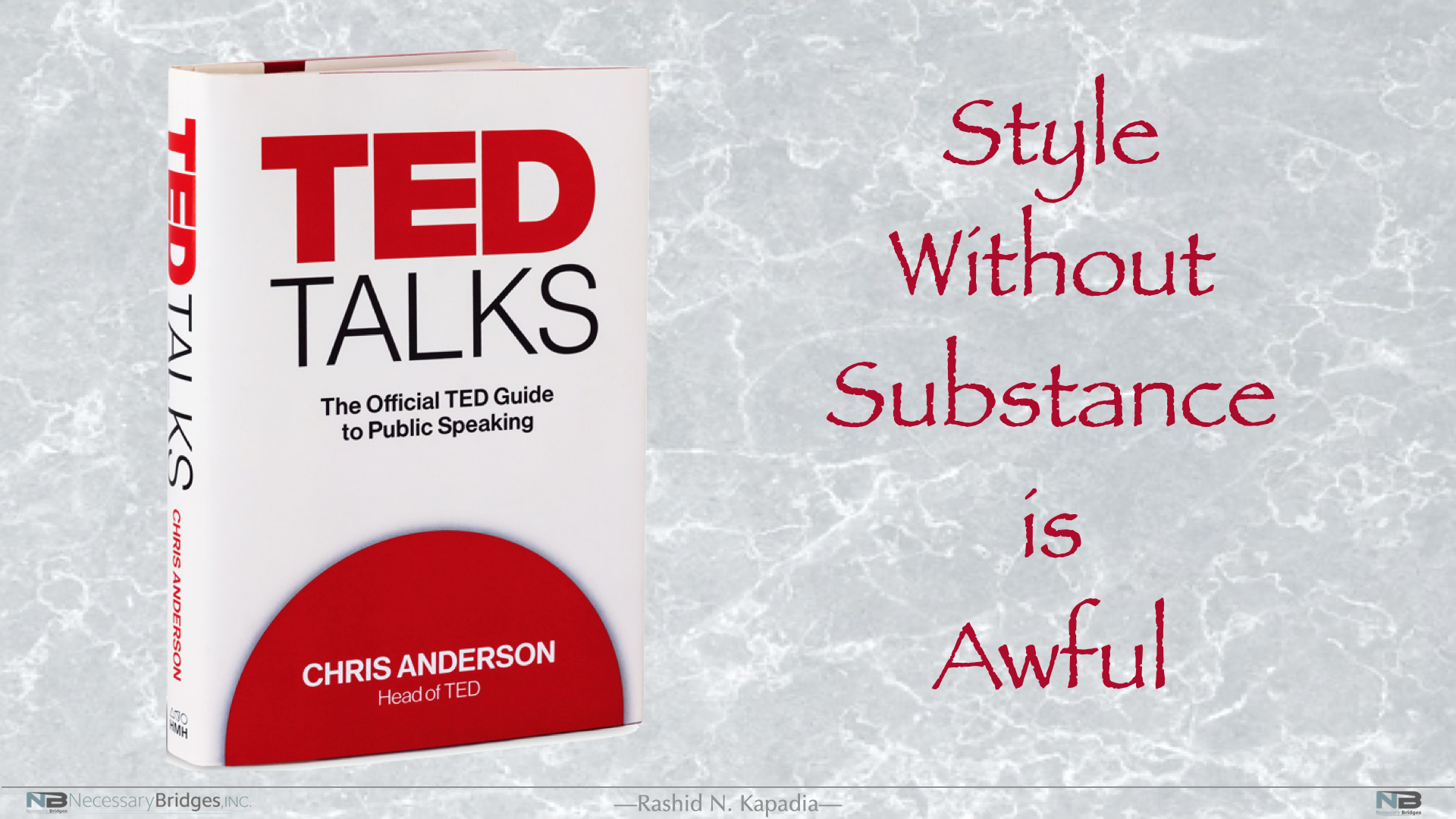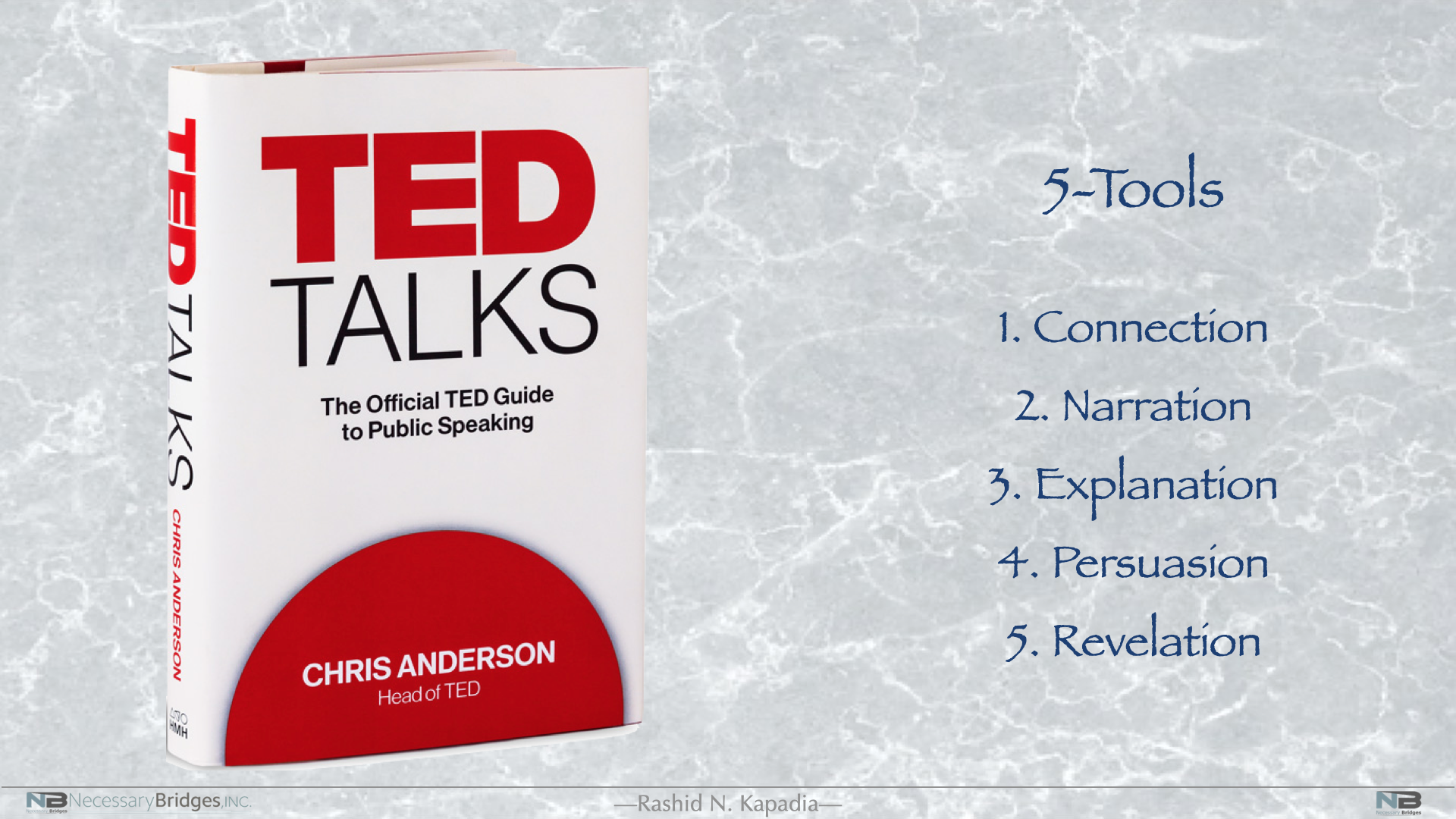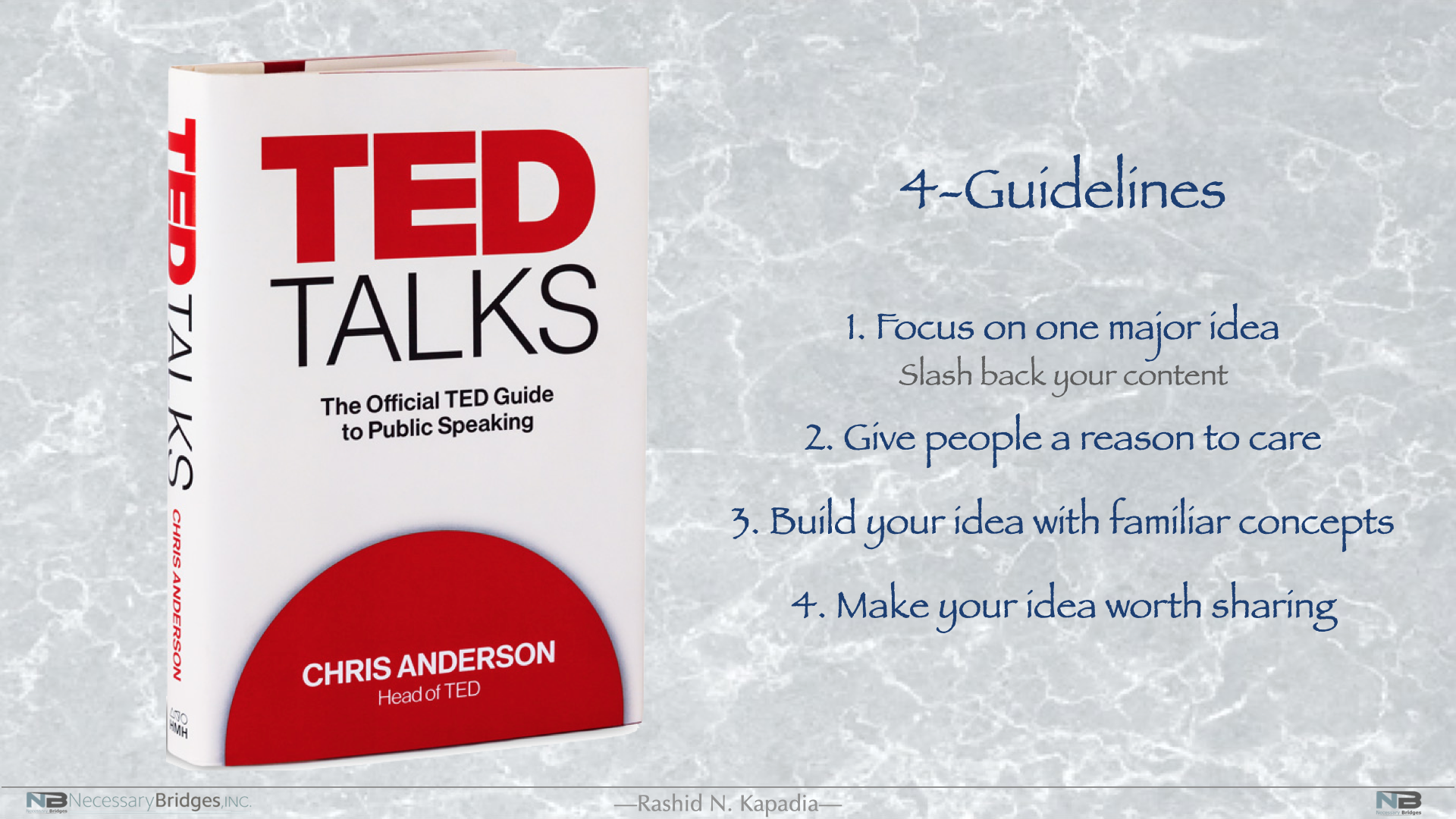Guidelines, Comments, Suggested Process and Check-Lists
for Speech Writing & Presentation Creation. And some Videos
THIS ABOVE ALL. This is your speech. You must own the speech.
Do not let anyone else, expert or coach, persuade you otherwise.
Yes, be guided by experts, coaches, and all feedback, but you must retain ownership.
This is your opportunity to contribute. And to connect. And to serve. And to shine.
Comments on speechwriting
My thinking about speechwriting is deeply influenced by Chapter 12: Speechwriting of Ted Sorensen’s 2008 book “Counselor: A Life at the Edge of History”
A great speech is built on 4 pillars: Clarity, Brevity, Levity, Charity.
Ted Sorensen developed a style of speech writing that can be boiled down to six basic rules. I always try and be guided by these.
- Less is almost always better than more.
- Choose each word as a precision tool.
- Organize the text to simplify, clarify, emphasize.
- Use variety and literary devices to reinforce memorability, not confuse or distract.
- Employ elevated but not grandiose language.
- Substantive ideas are the most important part of any speech.
A great speech has: An Outline, A Headline, A Frontline, A Few Sidelines, A Bottomline.
- An outline – a plan
- A headline – what’s the news, what do you want the public to take?
- A front line – what’s the most important point?
- A few sidelines – sidelines are quotations, humor and poems
- A bottom line – an ending that makes the audience leave the hall saying, “Now that was a memorable speech.”
To summarize & quote a truly great & legendary speechwriter Ted Sorensen
- A speech is made great, not from the words used, but from the ideas conveyed.
- If the ideas, principles and values and substance of the speech are great, then it’s going to be a great speech, even if the words are pedestrian.
- The words can be soaring, beautiful and eloquent but if the ideas are flat, empty or mean, it’s not a great speech.
Speechwriting really comes down to four words, five lines, and six basic rules.
- The four words: Clarity. Brevity. Levity. Charity
- The five lines: Outline. Headline. Frontline. Sideline. Bottom line.
- The six basic rules: 1. Less is better. 2. Words are precision tools. 3. Organize to simplify, clarify & emphasize. 4. Reinforce memorability. 5. Elevated (not grandiose) language. 6. Substantive ideas are the most important.
Creating a Speech / Presentation / Talk Rashid N.Kapadia Approach
- Before you ever start writing your talk, be very clear on your message. You should be able to reduce your message (or each point) to a single sentence or idea.
For example:
Every citizen can be a better citizen by becoming a better public speaker and storyteller.
OR
Every professional can be a more successful professional by becoming a better public speaker and storyteller. - Verify that your topic is relevant and appropriate for your audience—i.e. know your audience’s needs.
- Decide on what you want the audience to (1) Know (2) Feel & (3) Do.
For example:
I want my audience to know that they can become more successful by taking up public speaking and storytelling.
I want my audience to feel energized by experiencing the power of public speaking and storytelling.
I want my audience to commit (do: action item) to acquiring expertise in public speaking and storytelling. - Start with the end in mind. Deciding on the closing. Write out the ending, which must hammer home the key message. Decide on the final emotion you want to leave your audience with. Write an ending that will leave the audience with this emotion.
- Write out a strong opening. Must grab attention earliest.
For example: (Jamie Oliver @ TED)
Sadly, in the next 18 minutes when I do our chat, four Americans that are alive will be dead through the food they eat. - Write out a road map.
For example:
I will make three different points to reinforce a common theme which is …
OR (Steve Jobs 2005 Stanford Commencement address)
Today I want to tell you 3 stories from my life. That’s it. No big deal. Just three stories. - List your points systematically and logically. Expand on them
- Decide on and insert transitions.
- If you are going to use slides, this is the time to create them—not earlier. If you are going to use other props, this is the time to decide how & when to incorporate them.
- Tie it all together.
- Check the draft against some checklists.
- Run it by friends or colleagues who do not have your level of subject matter expertise or knowledge. The curse of knowledge blinds us all. Is it clear and simple?
- Give the speech conversationally—without sticking to the script—and record it.
- Transcribe the speech, i.e. write it out exactly as you spoke it. This converts the script from one written for the eye to one for the ear
- If you plan to memorize your script, then this is the time to start. Use the “Memory Palace” technique. To learn more. Joshua Foer @ TED.
You have not memorized your script well enough till (1) you can recite it at twice your normal speaking speed, or (2) you can recite your speech aloud while simultaneously doing another task that requires mental energy and concentration.
i.e. till it has become part of implicit memory–as opposed to explicit memory. - Practice in feedback rich environments repeatedly, edit repeatedly, and refine.
- Convert the final version to reading notes or cue cards.
- Practice even more in feedback rich environments.
- Develop and habitualize some “pre-speech-routines” that work best for you. Incorporate these routines into your practice sessions. And do them diligently and thoroughly before your actual presentation
- Your goal: “I must be in the FLOW state when presenting. This is the state in which I feel my best, and perform best!“
Image Source. https://www.myteacher.com.ng/course/public-speaking-strategies/
Basic-Simple STRUCTURE:
- Strong opening.
- Transition to Greeting and RoadMap.
- 1st point. (followed by—time permitting— 1 – 2 minute discuss and debrief segment)
- Clear transition.
- 2nd point. (followed by—time permitting— 1 – 2 minute discuss and debrief segment)
- Clear transition.
- … Continue this way through all points … (followed by—time permitting— 1 – 2 minute discuss and debrief segment)
- Clear transition to summary.
- Summary.
- Clear transition to Q&A / Discuss and Debrief session.
- Q&A / Discuss and Debrief session.
- Clear transition into strong closing.
- Strong closing.
10-point CHECKLIST:
- Do I have something worth saying? Am I making a contribution?
- Do I know my audience? Is my message audience focused? What do I want my audience to KNOW, FEEL and DO after hearing my presentation?
- Is my message focused and clear?
The most common issue with beginner speakers and 1st drafts is that they cover too much. Limit the presentation to that which can be explained with examples and stories—in the available time. - Do I have a strong closing? A strong opening? A clear roadmap? Good transitions?
- Is my talk characterized by CLARITY, BREVITY, LEVITY and CHARITY?
- Have I included stories and examples to support main points?
stories stick: facts get forgotten
facts tell: stories sell
tell a story, then make a point: or make a point, then tell a story - If I am using visuals, are they too crowded?
If slides take more than 2 – 3 seconds to fully comprehend, they are too crowded. - Have I practiced enough? In front of numerous and diverse audiences?
- Have I reached out for feedback & some coaching
- Am I being authentic? Do I come across as authentic?
Creating Slides
Top Guideline: A slide, like a headline, should take no more than 2 to 3 seconds to comprehend. Single images, or very few words, do this best.
Top Caution: Beware the temptation to create fancy feature filled slides that communicate anything other than your core message. The WOW factor is ephemeral. You will do fine without it.
- A PowerPoint is not the presentation. It is only a collection of slides. Each slide is only a visual aid: nothing more. You—your presence, your audience connection, your useful content, and your commitment to contribution—are the presentation.
- The time to use a slide is when it conveys ideas and information with greater “clarity and brevity” than the spoken word alone.
- A bad slide is worse than no slide. It takes your listeners’ attention away from you—breaking your connection—and causes confusion or distraction in your listeners’ minds.
My top recommendation for individual slides is “keep them super-simple”. Images do this best. Few words of text do this well.
I stay away from SmartArt, flashy transitions etc.. I ask myself: “What is the worst that will happen if I don’t use this fancy—and distracting—feature?” This keeps me anchored to basics and core message. Regarding formatting, I stay with one primary font, and change format (color, size, font) only if it contributes to clarity and brevity.
I study slides of excellent presentations, especially Apple product launches and TED Talks. Suggest you do the same.
Here are two examples of presentations with optimal slides. Notice the slides have only a support role. The slides are visual aids: nothing more.
And here is an example of a superb presentation with NO SLIDES. Ken Robinson @ TED. Notice how your attention never deviates from the speaker.
Be thoroughly familiar with this HBR article “How to Give a Killer Presentation” by Chris Anderson.
TED Talks Approach
from the book TED Talks: The Official TED Guide to Public Speaking by Chris Anderson
Checklist
- Is this a topic I’m passionate about?
- Does it inspire curiousity?
- Will it make a difference to the audience to have this knowledge?
- Is my talk a gift or an ask?
- Is the information fresh, or is it already out there?
- Can I truly explain the topic in the time slot allocated, complete with necessary examples?
- Do I know enough about this to make a talk worth my audiences time?
- Do I have the credibility to take on this topic?
- What are the 15 words that encapsulate my talk?
- Would those 15 words persuade someone that they’d be interested in hearing my talk?
5 Core Tools to Build a Talk
- Connection
- Narration
- Explanation
- Persuasion
- Revelation
These tools can be mixed & matched. Some talks use only one tool. Some use all five.
TED’s Secret to Great Public Speaking: Chris Anderson
There’s no single formula for a great talk, but there is a secret ingredient that all the best ones have in common. TED Curator Chris Anderson shares this secret — along with four ways to make it work for you. Do you have what it takes to share an idea worth spreading?
Your #1 task as a speaker is to build an idea in the minds of your audience.
Four Guidelines to go about that task:
- Focus on one major idea. Slash back your content.
- Give people a reason to care.
- Build your idea with familiar concepts.
- Make your idea worth sharing.
Chris Anderson: Talks at Google: TED Talks–The Official TED Guide Public Speaking
Steve Jobs Approach.
from the book: Presentation Secrets of Steve Jobs: How to be Insanely Great in Front of Any Audience by Carmine Gallo
Chapters
Prologue: How to be Insanely Great in Front of Any Audience
Act 1 Create the Story
Scene 1 Plan in Analog
Scene 2 Answer the One Question That Matters Most
Scene 3 Develop a Messianic Sense of Purpose
Scene 4 Create Twitter-like Headlines
Scene 5 Draw a Road Map
Scene 6 Introduce the Antagonist
Scene 7 Reveal the Conquering Hero
Intermission 1: Obey the 10-minute Rule
Act 2 Deliver the Experience
Scene 8 Channel Their Inner Zen
Scene 9 Dress Up Your Numbers
Scene 10 Use “Amazingly Zippy” Words
Scene 11 Share the Stage
Scene 12 Stage Your Presentation with Props
Scene 13 Reveal a “Holy Shit” moment
Intermission 2: Schiller Learns from the Best
Act 3 Refine and Rehearse
Scene 14 Master Stage Presence
Scene 15 Make It Look Effortless
Scene 16 Wear the Appropriate Costume
Scene 17 Toss the Script
Scene 18 Have Fun
Encore: One More Thing
Some Helpful Videos to Broaden Your Public Speaking Skill-Set.
TED Talk: Feats of Memory Anyone Can Do. Joshua Foer
Use the ancient “Memory Palace” to memorize your speech.
Watch Joshua Foer using a “Memory Palace” to memorize his TED Talk.
TED Talk: 7 Secrets of the Greatest Speaker in History. Richard Greene
“Never give a “Speech”, says Richard Greene. In this masterful talk, he explains how the great speakers in history use 7 secrets and how we can all become a great speaker by following these secrets and by not just giving a “speech” but rather creating “conversations” from the heart.
TEDx Talk: Allan Pease. Body Language: The Power is in the Palm of Your Hands
Learn about the three basic hand/palm positions and what they convey.
TED Talk. Speaking with Confidence. Caroline Goyder
Caroline Goyder shares a story of moving from stage-paralysis to expressive self. Accompanied by an unusual prop, she encourages us to use our voice as an instrument and really find the confidence within.
Three insightful points:
- Think of your voice as an instrument. A combination of strings (vocal cords) & air. Practice optimizing this instrument. Simplest way to exercise this instrument is to sing. Singing = Practicing = Exercising.
- The person with the most inner confidence—with the most power—is the person with the most relaxed breathing patterns. The person most able to be still and relaxed has the most inner confidence. The diaphragm is the king of confidence—the center of expression. Confidence resides in “Diaphragmatic Breathing”. The skill is to breathe low and slow.
- The big takeaway: In-breath is thought and emotion. Out-breath is expression. In Latin, inspiration and respiration have the same roots. Breath is thought. Controlling emotion and thought (confidence, for example) during in-breath, leads to an experience and expression of confidence on out-breath.
Opening Your Speech (From an 2015 Blog)
Successful presentation openings:
– grab the listener’s attention
– generate intellectual curiosity
– engender emotions and empathy
– produce a positive emotional connection
Example # 1: Mohammed Qahtani: (0:10 – 1:15)
A bold opening! This was a contest speech—at the highest level. As soon as the speaker completed his opening and transitioned to the 1st point, I mentally predicted he would win. This unusual opening adeptly tied into the speaker’s core message. To fully appreciate the quality of this opening, it is best to see the entire speech. I’ve been with Toastmasters for many years, but do not recall seeing an opening quite like this.
Well-done Mr. Qahtani! Thank you for your example.
Example # 2: Narendra Modi (1:15 – 2:10)
Another bold opening! The speaker, a politician, holds silence for 30 seconds in the first 45 seconds. A very large audience is won over. I had never seen this before. Super effective.
Additionally, it is risky for a politician to address an audience as “my loving brothers & sisters”, especially in the current climate of skepticism with politicians and leaders. Nonetheless this speaker boldly & successfully pulls it off.
Congratulations on a very bold opening Prime Minister Modi!
I challenge you, the reader, to open like this sometime.
Example # 3: Darren LaCroix (2:10 – 4:40)
Yet another bold opening! This is a splendidly crafted opening, with probing questions, humor, staging, and dramatics expertly delivered. While it is effortless and enjoyable to follow the speaker, do not be misled; this sophisticated opening is chock-a-block full of best practices. This is an opening worth studying. There is a lot going on underneath the surface. The speaker is clearly a world class SME (subject matter expert).
Thank you for sharing your expertise with the world Mr. LaCroix!
Next: ‘rule-of-3’ examples. While this rhetoric device is ubiquitous in speech transitions and bodies, it is not utilized as often in speech openings. When used, it can be very effective, as demonstrated by examples 4 to 7.
Example #4: Simon Sinek (4:50 – 6:05)
In this popular TED talk—23.6 million views—the speaker opens with questions. This technique, which leads to the premise brilliantly, is an underutilized opening option that is particularly suitable for ‘new-ideas-in-business’ presentations.
Thank you Mr. Sinek for demonstrating the power of this rhetoric device.
Examples #5, #6 & #7: Barack Obama (6:06 – 8:25)
President Obama uses the rule-of-3 technique in his speech openings routinely. We see examples here from three milestone speeches. He excels in making it seem natural.
There is polish and elegance to be had by using this approach in presentation openings.
Example #8: Apple Special Event (8:25 – 10:25)
Of all the ‘presentation-opening’ examples discussed, this is my favorite. Since 1984 Apple has been at the forefront of great corporate presentations. The excellence continues here. All the ‘great-presentation-openings’ criteria have been achieved—before the speaker even steps on stage. Marvelous!
Attention captured? YES
Interested in hearing more? Curious about what’s to come? YES
Experienced positive emotions? YES
Feel connected to the Apple approach/story? YES
Well done indeed!
It is easy to predict that other corporations will either emulate this example, or fall further behind. Here is an organization boldly stating what it stands for! Very nice.
Example #9: Documentary: America: The Story of Us (10:35 – 10:55)
I have included this example because it simply jumped out at me.
Let no one ever convince you that 4 sentences and 15 seconds isn’t enough for an outstanding opening.
4 sentences in 15 seconds = mission—powerful opening—accomplished
simplicity = sophistication
Example #10: Obama 2004 DNC (11:00 – 14:15)
This speech has an unparalleled legacy.
It made a POTUS President Of The United States
Every aspiring and advanced speaker should study this speech. It is chock-a-block full of rhetoric devices and best practices.
In the opening three minutes, the speaker shares his family’s life stories, and successfully contextualizes these as quintessentially American.
It is a truly remarkable achievement! Splendid speechwriting.
